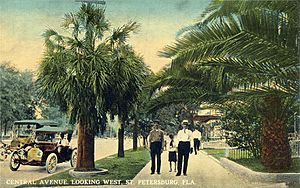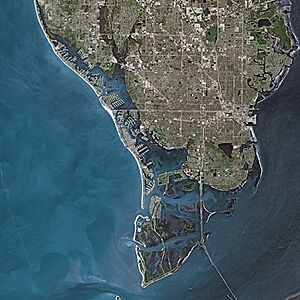History of St facts for kids
Quick facts for kids History of Florida |
|
|---|---|

The seal of Florida reflects the state's Native American ancestry
|
|
| Historical Periods | |
| Pre-history | until 1497 |
| Spanish Rule | 1513–1763 |
| British Rule | 1763–1783 |
| Spanish Rule | 1783–1821 |
| U.S. Territorial Period | 1822–1845 |
| Statehood | 1845–present |
| Major Events | |
| American Revolutionary War | 1775–1783 |
| War of 1812 | 1811–1814 |
| First Seminole War | 1817–1818 |
| Capitol moved to Tallahassee |
1824 |
| Second Seminole War | 1835–1842 |
| Constitutional convention | 1838 |
| Third Seminole War | 1855–1858 |
| Ordinance of Secession | 1861 |
| Civil War | 1861–1865 |
| 3rd Constitution | 1865 |
| Reconstruction | 1865–1868 |
| 4th Constitution | 1868 |
| 5th Constitution | 1885 |
| Great Migration | 1910–1930 |
| Land Boom | 1925–1929 |
| 6th Constitution | 1968 |
| Gore v. Harris 2000 Presidential Election |
2000 |
| Timeline | |
St. Petersburg is a city in Florida with a rich history. It was started by two important people: John C. Williams from Detroit and Peter Demens. Peter Demens helped bring the Orange Belt Railway to the area in 1888. The city officially became a town on February 29, 1892. Back then, only about 300 people lived there.
The city got its name from Saint Petersburg, Russia. That's where Peter Demens grew up. A fun story says that John C. Williams and Peter Demens flipped a coin to decide who would name the new city. Peter Demens won and chose the name St. Petersburg. John C. Williams then named the first hotel, built by Demens, after his own hometown, Detroit. The Detroit Hotel is still in downtown St. Petersburg today, but it's now a condominium. Some of the oldest hotels still operating are the historic Pier Hotel, built in 1921, and The Heritage Hotel, built in 1926.
Early Growth and Industries
In 1897, Philadelphia publisher F. A. Davis brought the first electricity to St. Petersburg. A few years later, in 1904, the city got its first trolley service. This made it easier for people to get around.
The city's first big business started in 1899. Henry W. Hibbs began a wholesale fish company at the end of the railroad pier. This pier reached out to the main shipping channel. Soon, his company was shipping over 1,000 pounds of fish every day!
To help bigger ships come to St. Petersburg, a deeper shipping channel was dug between 1906 and 1908. More improvements were made to the port in the 1910s. By this time, the city's population had grown a lot, reaching 4,127 people.
First Commercial Airline
St. Petersburg is famous for being the home of the world's first scheduled commercial airline flight. This happened in 1914. An airplane flew across Tampa Bay from St. Petersburg to Tampa and back.
The company was called the St. Petersburg-Tampa Airboat Line. The pilot was Tony Jannus, and he flew a special Benoist XIV flying boat. Today, the Tony Jannus Award is given each year to people who have done amazing things in the airline industry. There's also a local music spot downtown called Jannus Live, named after him.
Population Changes Over Time
The number of people living in St. Petersburg kept growing throughout the 20th century. It grew especially fast in the 1940s, 1950s, and 1970s. Many people from midwestern cities chose St. Petersburg as a place to retire.
By the 1980 census, the population reached 238,647. However, after that, the growth slowed down. Since 1980, the population has only increased by about 10,000 people. Between 2000 and 2010, the city's population actually dropped by about 4,000 residents. During the same time, the population of Florida as a whole grew by over two and a half million people.



